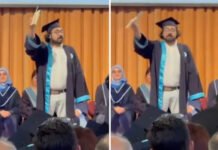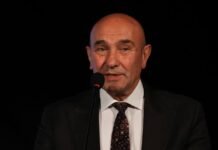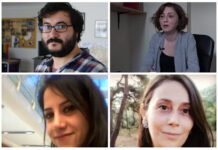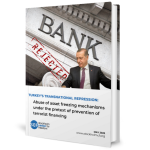Turkey’s Islamist President Recep Tayyip Erdoğan recited an Islamic prayer on Saturday in the Hagia Sophia museum, a historic İstanbul landmark that has become a symbol of interfaith and diplomatic tensions.
According to a report by the Hürriyet Daily News, Erdoğan called on guests attending the opening of a festival to join him in silently reciting the first verse of the Quran, dedicating the prayer to the “souls of all who left us this work as inheritance, especially İstanbul’s conqueror.”
The Hagia Sophia was built during the sixth century Christian Byzantine Empire and served as the seat of the Greek Orthodox Church. It was converted into an imperial mosque with the Ottoman conquest of İstanbul in 1453. Turkey’s secular founder Mustafa Kemal Atatürk made the structure a museum in 1935, but there have been calls in recent years to turn it back into a mosque.
Erdoğan went on to complain about Turkey’s ineffectiveness in promoting its arts and culture and accused those “who were more Western than the West and engaged in a fight against the values of the Turkish nation.”
“Some of our historic mosques have been turned into museums,” he said, pointing to the Hagia Sophia and claiming that “in the period of single party rule in Turkey alone, more than 300 hundred holy places were destroyed” on İstanbul’s historical peninsula.
Turkey was ruled by a single party between 1923, when Atatürk founded the new nation, and 1946, when democratic elections, albeit flawed ones, were first held. The secular values of Turkey’s leaders in this period have come under regular criticism from Erdoğan and others in his party.
Thousands of Muslim Turks have prayed outside the Hagia Sophia over the years to demand that it be restored as a place of worship. In 2015, a cleric recited from the Quran inside the building, a UNESCO World Heritage site, for the first time in 85 years.
The following year, Turkey’s religious authority began hosting and broadcasting religious readings during the holy month of Ramadan and the call to prayer was recited to mark the first revelation of the Quran to the Prophet Muhammad.
Speaking at the opening of the first Yeditepe Biennial, focusing on classical Turkish art, Erdoğan also said on Saturday that it was “difficult and emotional” to be speaking at the Hagia Sophia, which he described as “magnificent and holy.”
Greece has protested the Turkish government’s religious use of the venue, calling it last summer an “affront to the international community,” The Associated Press reported. The Turkish Foreign Ministry condemned the Greek statement, saying it distorted the events and arguing that Greece made it difficult for Muslims to practice their faith.
Heather Nauert, the US State Department spokesperson at the time, said the venue had a “great significance to other faiths, many faiths” and called on Turkey to “preserve the Hagia Sophia in a way that respects its complex history.”
According to a report by online news outlet Ahval, Erdoğan also said on Saturday that artists who wanted to produce new works of art for their society were excluded in that period and that this “top-down, repressive, Jacobin understanding” still continues today among some artistic circles.
Those artists who supported Turkey’s recent military campaign in Syria were also being criticized for this stance, he added. “They have said every bad word against our artists who displayed a nationalist stance, who tried to raise the spirits of our soldiers. Those people are no different than neighborhood bullies. Due to their mentality, they are modern Bedouins,” he said.
Erdoğan noted that they have changed this cultural paradigm in Turkey. “They destroyed, we built. They are still trying to destroy. We are still trying to build,” he said. Erdoğan then recalled the Gezi protests of 2013 and the dispute on the future of Ataturk Cultural Centre at the time.
“Now we are transforming the Atatürk Cultural Centre into one of the world’s best opera venues. Those Gezi protestors also protested against this. You can yell as much as you want. Rant and rave, [but] we demolished it.”
The Gezi protests started as a peaceful sit-in protest on May 28, 2013 against the cutting down of trees in Gezi Park in Taksim Square, Istanbul. The protests turned into a countrywide revolt after police began assaulting protestors with tear gas and water cannons. For more than two weeks, Taksim Square was occupied by the protestors, whom Erdoğan called “a few looters”. According to reports by human rights organisations, 11 people died and more than 8,000 others were injured in Turkey during the protests.
The Ataturk Cultural Center (AKM) in Taksim Square was among the issues that led the protestors to take to the streets during the Gezi protests. The construction of the AKM, one of the icons of Turkish modern architecture, itself has a symbolic cultural value. President Erdoğan and his Justice and Development Party have come up with various projects for reconstructing Taksim Square which have contributed to the cultural polarization in Turkey between the secularists and the Islamists. The government first planned to renovate the AKM but later decided to demolish it and build an opera house. The demolishing of the AKM began in February 2018, while a new mosque is being built in the square just across from it.
Ironically, in politicizing construction in Taksim Square at the heart of Istanbul, Erdoğan himself is following the lead of İsmet İnönü, Turkey’s second president and “national chief” during single-party rule, who commissioned a large number of triumphal statues to be put in the square before losing the 1950 elections, whereupon the statues were scrapped.
















[…] Source link […]